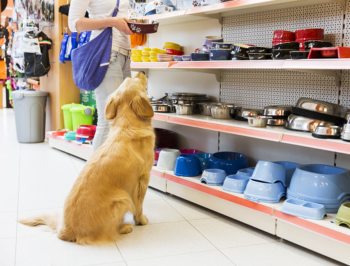Inflation, taxes, and the cost of living are on the rise. Pet owners, feeling the financial strain, often look for ways to trim their pet care budget. Stuffed toys get destroyed, scratching surfaces get shredded, dishes go amiss, and kibble doesn’t refill itself. Regardless, pet owners want their pets to have it all, but pet supplies can be expensive, and since we’re always replacing them, the costs add up quickly! Thankfully, there are ways you can cut back on spending on your pets while also enhancing their quality of life! Read on to find out how (no magic necessary).
Feed your pet the right amount of food. Before you downgrade your pet’s food, consider this: close to 60% of cats and dogs are overweight or obese, and a survey of veterinarians revealed that the most common health mistake pet owners make is overfeeding. This means we have a two-fold opportunity to save money on pet food while helping trim our pets’ waistlines.
Pet food feeding instructions from manufacturers often provide vague ranges of portion sizes, and they often don’t account for the calories from treats in your pet’s diet. This means pet owners usually don’t realize that they are overfeeding their pets. Additionally, a measuring cup is the most common tool used to dish out proper portions, but this is also problematic; studies have shown that by this method, most people overestimate the portion sizes by up to 50% (the average being about 15%). The impact of these misunderstood portion sizes and inaccurate measurements is that a bag of kibble doesn’t last as long as it should, and consistent overfeeding leads to unhealthy weight gain and other health problems for otherwise healthy pets.
Ask your veterinarian how much to feed your pet for healthy weight maintenance and consider using a digital gram scale to measure dry food by weight, as it is far more accurate and consistent than a measuring cup.
Choose quality over quantity. It’s often worth spending a little extra for supplies that can stand the test of time. An indestructible $90 dog bed with a laundry-safe removable cover could last two to three years while a less durable $40 bed of the same size may need to be replaced in six months. Additionally, items that are more durable are safer for your pet. Small shreds of fabric, string, or pieces of plastic are easy to swallow but can be very difficult (and expensive) to remove if your pet can’t pass them in their stool.
Repurpose “people stuff” as “pet stuff”. Supplies marketed for pets tend to be priced significantly higher than similar “human” versions. Consider a stainless-steel food dish from a pet store compared to a similar mixing bowl for baking from a kitchen store. Fleece blankets, storage bins, car seat covers, and even canned pumpkin puree are all examples of supplies that come with higher price tags when marketed for pet use. Be conscientious, however, that the “people” stuff you choose for your pets are in fact pet safe.
Try some DIY. Making your own pet supplies can be a creative new experience and you probably already have a lot of the materials at home! You can make a covered bed for your cat with a wire hanger and an old T-Shirt, or a scratching post with sisal rope and PVC pipe. Slow feeders can be made with egg cartons and cardboard boxes. Check YouTube and Pinterest for inspiration. You may come across something you’ve never thought of and end up creating your pet’s new favorite thing!
Keep up with preventive health care. An ounce of prevention is worth a pound of cure, right? That applies to your pet’s health and your wallet. Routine veterinary check-ups, vaccinations, and parasite preventives minimize your pet’s risk of developing serious health problems and, if a problem does develop, the sooner it is detected and treated, the easier and less expensive it will be to manage. Many veterinary clinics offer wellness programs that bundle all the recommended preventive health care services at a discounted rate. The upfront cost may cause some reluctance, but you will end up saving in the end. Sometimes, these packages include exclusive discounts on pet food, treats, toys, and nail trims, too. These programs are worth their weight when it comes to keeping your pet healthy and wallet happy.
LifeLearn News
Note: This article, written by LifeLearn Animal Health (LifeLearn Inc.) is licensed to this practice for the personal use of our clients. Any copying, printing or further distribution is prohibited without the express written permission of Lifelearn. Please note that the news information presented here is NOT a substitute for a proper consultation and/or clinical examination of your pet by a veterinarian.


